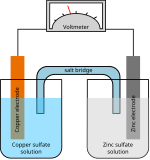Zamboni pile
Appearance


The Zamboni pile (also referred to as a Duluc Dry Pile[1]) is an early electric battery, invented by Giuseppe Zamboni in 1812.
A Zamboni pile is an "
gilded on one side or silver paper smeared with manganese dioxide[2] and honey might be used.[3] Discs of approximately 20 mm diameter are assembled in stacks, which may be several thousand discs thick, and then either compressed in a glass tube with end caps or stacked between three glass rods with wooden end plates and insulated by dipping in molten sulfur or pitch.[4]
Zamboni piles of more modern construction were manufactured as recently as the 1980s for providing the accelerating voltage for
lithium ion batteries.[5]
The
nanoampere range.[2][6] The famous Oxford Electric Bell, which has been ringing continuously since 1840, is thought to be powered by a pair of Zamboni piles.[7]
See also
References
- ^ Beaty, William J. (1996). "The DuLuc Dry Pile High-Voltage Source". Archived from the original on 17 December 2023. Retrieved 15 March 2024.
- ^ .
- ^ Stillman, Benjamin (1861). Principles of Physics. Theodore Bliss. p. 576.
- ^ Tinazzi, Massimo (1996). "Perpetual Electromotive of Giuseppe Zamboni". Archived from the original on 5 November 2019. Retrieved 18 January 2008.
- ^ "Infra-red Image Converters". The Valve Museum: The Radio Constructor. November 1961. Archived from the original on 2 December 2023. Retrieved 15 March 2024.
- ^ University of Innsbruck. "Zamboni's pile". Experimental Physics Museum. Archived from the original (Image with caption) on 27 February 2008.
- ^ "Exhibit 1 – The Clarendon Dry Pile". Oxford Physics Teaching, History Archive. Archived from the original on 7 March 2024. Retrieved 18 January 2008.

